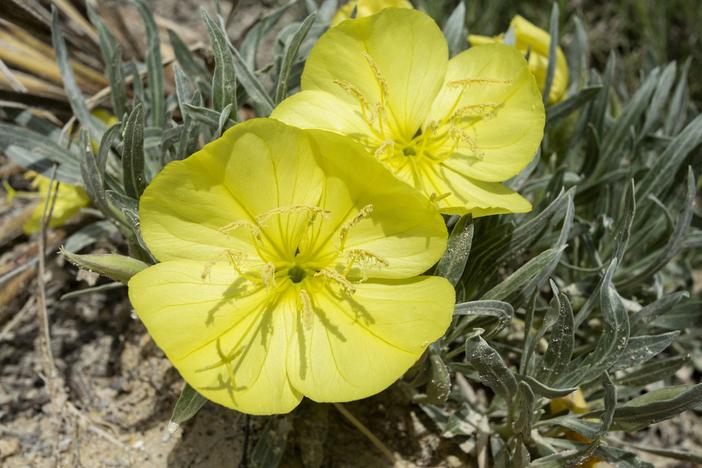Bigfruit Evening Primrose
(Oenothera macrocarpa subsp. macrocarpa)
Bigfruit Evening Primrose (Oenothera macrocarpa subsp. macrocarpa)
/
/

Cecelia Alexander
CC0 1.0
Image By:
Cecelia Alexander
Recorded By:
Copyright:
CC0 1.0
Copyright Notice:
Photo by: Cecelia Alexander | License Type: CC0 1.0 | License URL: https://creativecommons.org/publicdomain/zero/1.0/ | Uploader: aspidoscelis | Publisher: Flickr





















Estimated Native Range
Summary
Oenothera macrocarpa subsp. macrocarpa, commonly known as Bigfruit Evening Primrose, is a deciduous perennial herb that is native to rocky prairies and glades in the Central United States. It typically grows to a height of 0.3-1 feet (0.09-0.3 meters) and spreads 1-2 feet (0.3-0.6 meters). The plant forms a low rosette of lance-shaped leaves and is known for its large, showy, yellow flowers that bloom from late spring to early fall, adding a splash of color over an extended period. The flowers open in the evening and close by the next noon on sunny days, hence the name "evening primrose."
Bigfruit Evening Primrose is valued for its drought tolerance and ability to thrive in poor, rocky soils, making it a suitable choice for xeriscaping and naturalistic plantings. It is often used in rock gardens, borders, and native plant gardens. This species prefers full sun and can tolerate a range of soil types, provided they have good drainage. While generally low-maintenance, it can be susceptible to root rot in overly wet conditions. Gardeners appreciate its ability to attract pollinators such as bees and butterflies.CC BY-SA 4.0
Bigfruit Evening Primrose is valued for its drought tolerance and ability to thrive in poor, rocky soils, making it a suitable choice for xeriscaping and naturalistic plantings. It is often used in rock gardens, borders, and native plant gardens. This species prefers full sun and can tolerate a range of soil types, provided they have good drainage. While generally low-maintenance, it can be susceptible to root rot in overly wet conditions. Gardeners appreciate its ability to attract pollinators such as bees and butterflies.CC BY-SA 4.0
Plant Description
- Plant Type: Herb
- Height: 0.3-1 feet
- Width: 1-1.5 feet
- Growth Rate: Moderate
- Flower Color: Yellow
- Flowering Season: Spring, Summer, Fall
- Leaf Retention: Deciduous
Growth Requirements
- Sun: Full Sun
- Water: Low, Medium
- Drainage: Medium
Common Uses
Bank Stabilization, Bee Garden, Bird Garden, Border Plant, Butterfly Garden, Deer Resistant, Drought Tolerant, Fire Resistant, Fragrant, Groundcover, Hummingbird Garden, Low Maintenance, Potted Plant, Rabbit Resistant, Rock Garden, Showy Flowers
Natural Habitat
Native to rocky prairies and glades in the Central United States
Other Names
Common Names: Fluttermill , Missouri Evening Primrose
Scientific Names: Oenothera macrocarpa subsp. macrocarpa , Oenothera missouriensis , Megapterium missouriense , Oenothera alata , Megapterium missouriensis , Megapterium macrocarpum , Megapterium nuttallianum , Oenothera macrocarpa var. missouriensis
GBIF Accepted Name: Oenothera macrocarpa subsp. macrocarpa